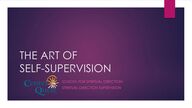
Return to flip book view
THE ART OF SELF-SUPERVISIONSCHOOL FOR SPIRITUAL DIRECTION: SPIRITUAL DIRECTION SUPERVISION
Definitions and Descriptionsu The ability to understand one’s capability, evaluate one’s skills, estimate one’s qualities, and organize oneself in order to grow u The effort taken to evaluate and assess one’s activities in a particular areau “Internal supervision”u A self-initiated and self-maintained processu Process of engaging in self-awareness, self-action, and self-evaluationu Specifically in the area of spiritual direction: A process of prayerful self-reflection on how one was being with the directee, what was said, what wasn’t said, what one was experiencing (feelings, thoughts, sensations, intuitions), what was noticed (both in oneself and in the directee), what might have been missed at the time.
What is Necessary?u In order to be able to engage in a process of self-supervision, one must have a good understanding of the theoretical/theological/philosophical framework that provides the basis or guide with which to “evaluate” oneself.u Some guide questions:u What is your theoretical/theological/philosophical understanding of spiritual direction? u What is your understanding of what spiritual direction is?u How do you understand the role of the spiritual director? What is the stance the director is to take in relation to God and the directee?u What is the role of discernment in spiritual direction?
What Self-Supervision is NOTu It is not a checking of one’s behaviors against a set checklist.u While there may be certain things that “should” be done or “shouldn’t” be done, self-supervision in spiritual direction is a prayerful, contemplative self-compassionate process of the heart that transcends a pre-established series of do’s and don’ts.u It is not an opportunity for self-shaming or self-criticizingu Rather, it is another opportunity to practice self-compassion and self-graciousness. It is another opportunity to open oneself to the experience of God’s grace and invitationu It is not a substitute for supervisionu It can be used when supervision is not available and/or as a preparation for supervision
Some Means of Self-Supervisionu Journaling (see book chapter by McCormack)u Utilizing the CRFu Writing out a dialogue from a portion of the direction sessionu Walking the Labyrinth with a direction session in mindu Engaging in an Examen (see module material)
Self-Supervision as an Artu The art of self-supervision comes in the form of gentle self-evaluation and self-reflection colored by self-compassion and a self-graciousness.u The backdrop of this process is the director’s own ongoing and deepening experience of God’s gentleness, compassion, and graciousness in their growing intimacy with Divine Mystery.u The director holds within them an embodied knowledge of what constitutes spiritual direction: their theological/philosophical/theoretical framework for how the Holy Spirit works through the director, as well as independent of the director (i.e., directly with and in the directee) to bring the directee into greater friendship and intimacy with God.u It is within this framework that the director is able to allow God to reveal any growing edges and/or places of celebration.